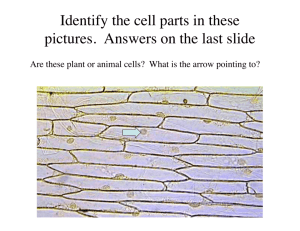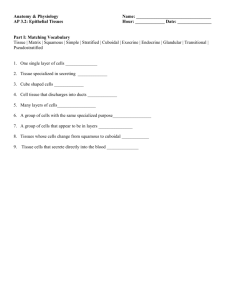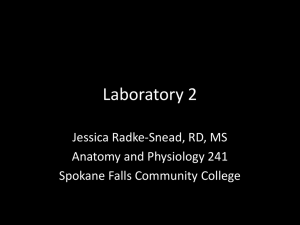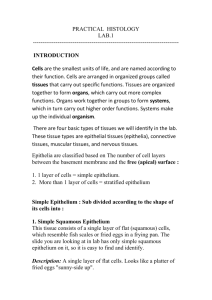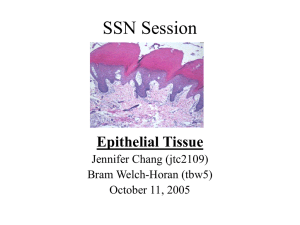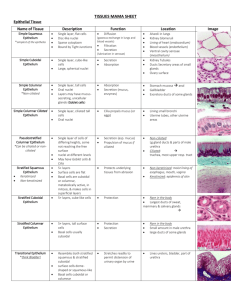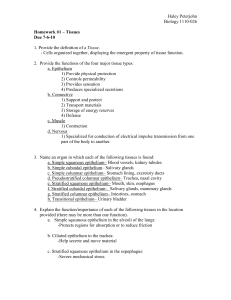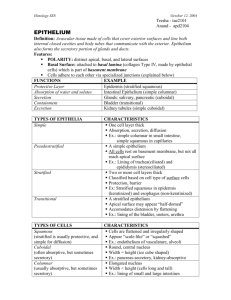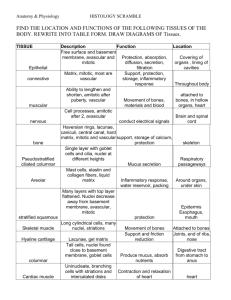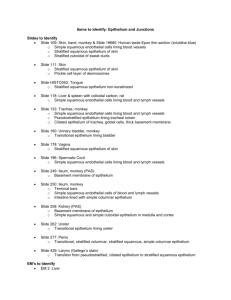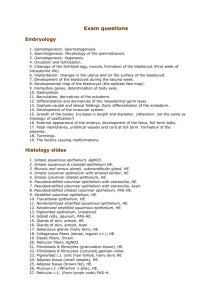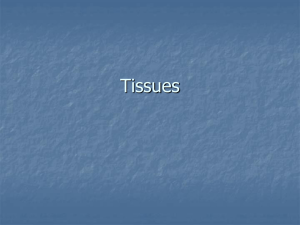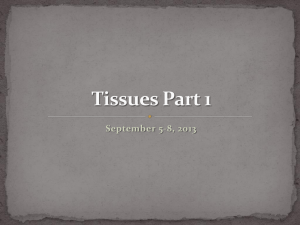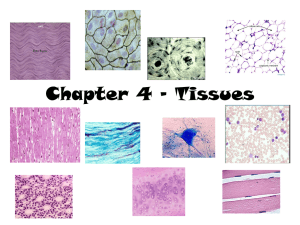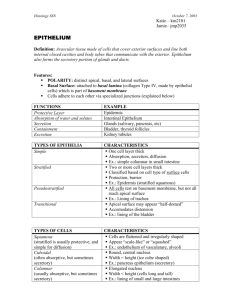BMED 2801 – Lecture 9 – Epithelium Classification of Epithelium
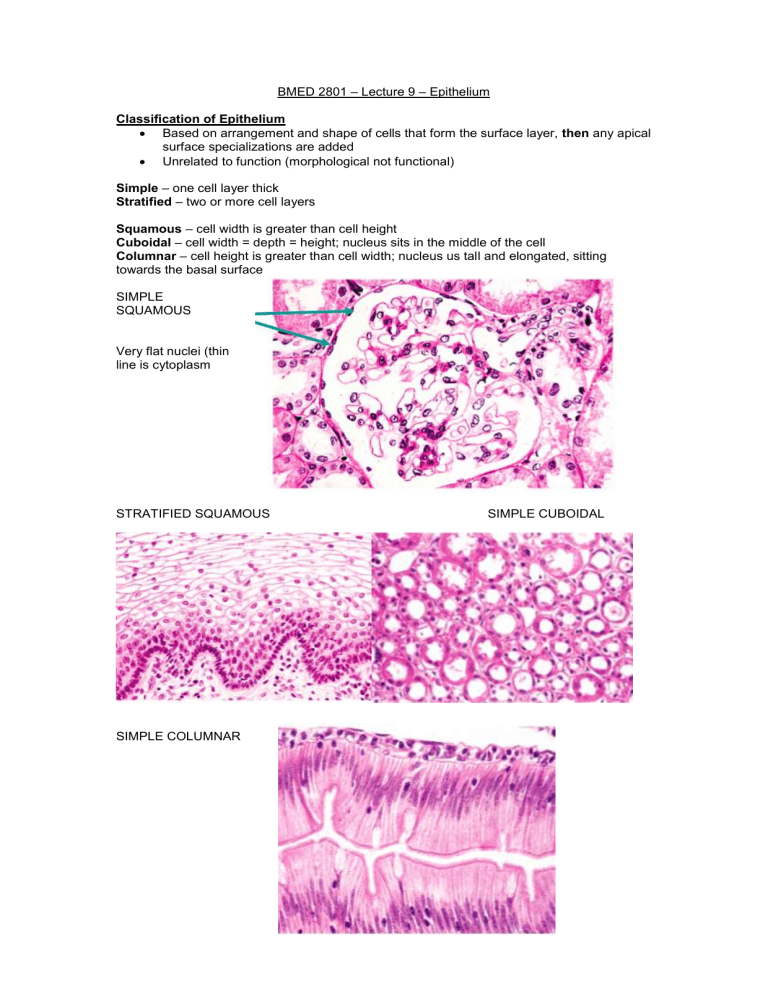
BMED 2801 – Lecture 9 – Epithelium
Classification of Epithelium
Based on arrangement and shape of cells that form the surface layer, then any apical surface specializations are added
Unrelated to function (morphological not functional)
Simple – one cell layer thick
Stratified – two or more cell layers
Squamous – cell width is greater than cell height
Cuboidal – cell width = depth = height; nucleus sits in the middle of the cell
Columnar – cell height is greater than cell width; nucleus us tall and elongated, sitting towards the basal surface
SIMPLE
SQUAMOUS
Very flat nuclei (thin line is cytoplasm
STRATIFIED SQUAMOUS SIMPLE CUBOIDAL
SIMPLE COLUMNAR
Pseudostratified Columnar Epithelium
All cells rest on the basement membrane but do not all reach the surface
Found in the trachea and epididymis
Basal cuboidal cells + columnar cells
Basal cells (steam cells) differentiate into mature cells to balance cell turnover
PSEUDOSTRATIFIED COLUMNAR CILIATED EPITHELIUM
Transitional
True stratified
Cuboidal
Impermeable to salts and water
Accomodates distension
Found in kidney minor calyses, ureter, bladder, urethra
LM – cuboidal, dome-shaped apical surface
EM – plaques = plasma membrane folds + actin filaments e.g. The walls of the bladder require pliability and elasticity. As the bladder fills, the cuboidal cells stretch out, appearing like squamous cells. The extremely strong, well functioning junctions keep the cells together.
Endothelium and Mesothelium
Both are simple, squamous epithelium
Endothelium lines vessel walls (tubular structures with a lumen, but not exposure to the surface).
Mesothelium lines the walls and covers organs of the thoracic, pericardial and abdominal cavities. Macroscopically it is seen as a smooth, shiny surface.
Functions of Epithelium
Need movement, therefore don’t want lots of layers.
Against physical AND chemical.
Will always be at the ends of bodily caivities (where it is exposed to the outside)
Cell height reflects secretory/absorptive activity.
Squamous epithelium indicates high rates of turnover.
Stratification correlates with impermeability.
The greater the number of layers, the greater the impermeability of the epithelium
Skin
Composed of three layers
*No matter where on the body, there are always three layers. The thickness of each varies
1. Epidermis – stratified squamous epithelium
2. Dermis – dense, irregular connective tissue; provides tension and tensile strength to skin and epidermis; contains lots of fibres
3. Hypodermis – fatty cell layer, loose connective tissue
Receptor
What’s associated with the skin?
Sweat glands
Hairs
Sebaceous glands
Nails
Function of Skin
Protection Physical, chemical, biological
Pain, pressure, touch, temperature through sensory axonal contacts
Absorption
Excretion
Hydration
Vitamin D within the skin
The number of receptors varies over skin, especially for touch
Lipid-soluble substances
Sweat, oils
Prevents water loss through barrier that top cells create
Heat regulation
Epidermis Layer of Skin
Thick skin has 5 layers (i.e. palms, soles)
Thin skin has 4 layers and hairs
The 5 layers of thick skin: s.basale
Single layer of small stem cells and keratinocytes (which will eventually produce keratin)
Mitotically active
can see pale unwound chromatin in nucleolus
Rest on basal lamina
Connected via desmisomes (very strong)
Large nucleus
Intense pink staining, slightly granular cytoplasm
s. spinosum
Several cells deep
Cytoplasmic processes (spines)
ladder-like borders between cells
Connected via desmosomes at the spines, seen as projections
Nucleus and nucleolus are very obvious (active cells)
Number of layers vary, ~3 – 20 s. granulosum
Cytoplasm contains keratohyaline granules (stain very blue)
Stains strongly with haematoxylin
Granular appearance
Beginning of waterproofing
Mechanical protection
s. lucidum
Thin, not easily seen
Cytoplasm is filled with keratin
Single layer
The closer to the surface contains more keratin and hyelin s. corneum
Thickness varies
No nucleus or organelles, they are non-functioning apoptotic cells (dead)
Cytoplasm is filled with keratin
Plasma membrane thickening and glycolipid coating (produced by cells in granulosum)
Flaky skin on surface
Final layer of waterproofing
Cells of the Epidermis
Keratinocytes
Epithelial derived cells
Lots of free ribosomes
Contain kertain filaments
(tonofilaments)
Melanocyte
Pigment cell (melanin)
Round and plump
Long dendritic processes
Located in the s.basale and scattered among s. spinosum layer
Pale staining in electron microscopy
Same number of cells present no matter skin colour, but the extent of cytoplasmic extensions varies and the amount of melanin
Melanin is transferred to keratinocytes via endocytosis
Tyrosine dihydroxyphenylalanine melanin
*M – Melanocyte; *K - Keratinocyte
Melanin is needed for other biological functions in the body e.g. sleep functions can be affected by melanin functioning (i.e. if always in the sun or darkness).
*In the autonomic recessive disease phenylketonuria, the enzyme to produce tyrosine is missing, and melanin cannot be produced. A change in the diet to get the right amino acids will prevent a build up of toxins as a result.
Langerhan cell
Antigen-presenting
Phagocytic
Long dendritic processes
Rough nuclear shape
Merkel cell
Found in the s. basale
Modified and differentiated epithelium cell
Contain cytoplasmic granules
(catecholamines) are neurotransmitters
Desmosomal contact to other cells
Involved in touch sensations - basal plasma membrane contacts with nerve fibres (mechanoreceptor)
Very active cells
very pale euchromatin
Tucked in between stem cells


